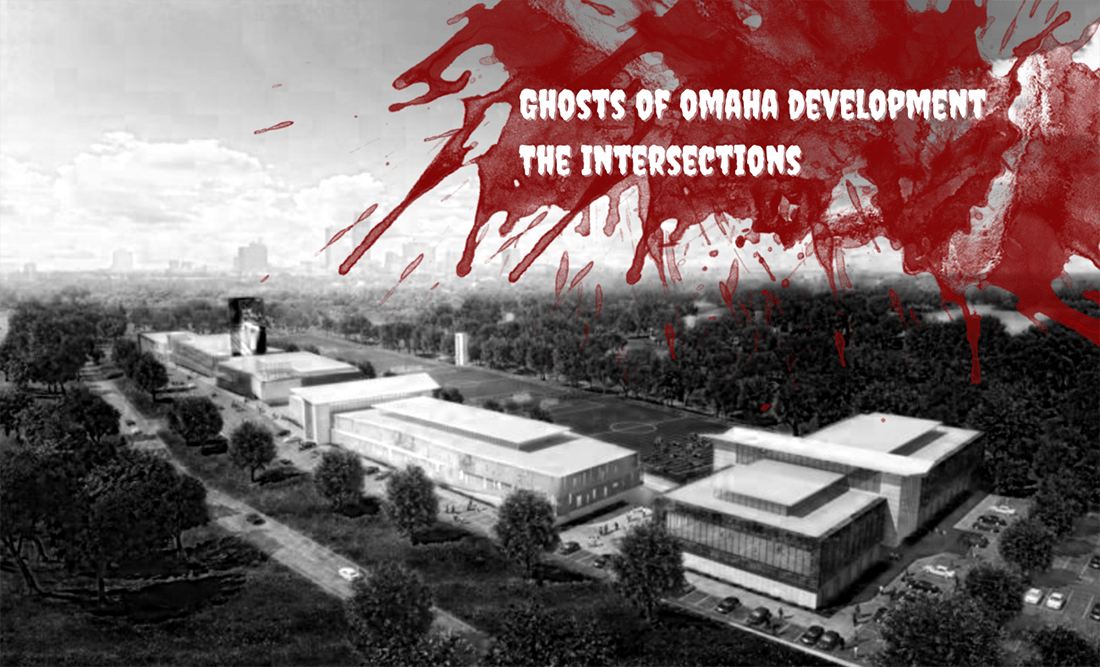In November 2021, Community Health Development Partners (CHDP) announced a plan for a 25-acre health and wellness campus called The Intersections. The development’s now-defunct website described it as “a place where opportunity, fun, and wellness come together for everyone.”
The Intersections campus, located near South 28th and Martha streets, was planned to have five buildings totaling 300,000 square feet at an estimated cost of $100 million. Each building would have housed a “key component” to draw people from around the region and positively impact the community.
The facilities included:
- A technology and esports center featuring technology labs, educational spaces, and a large esports arena unique to the region
- An action sports facility with an indoor skate park, bouldering area, foam pit, and tumbling gym
- A wellness center offering a broad range of medical and wellness services, including primary care, pediatrics, women’s health, integrative care, behavioral healthcare, massage, yoga, and relaxation/meditation with onsite daycare
- A sports, fitness, and rehab facility housing athletic training, physical and occupational therapy, an athletic performance training center, eight basketball and volleyball courts, four multi-turf fields, sports simulators, a fitness gym, and opportunities for everyone at all fitness levels
- A community center/food hall/nonprofit incubator including an urban farming center, office space, and a corporate and community training center
CHDP’s website describes its work as “centered around making recreational, wellness, and healthcare options more accessible to low-income individuals, people of color, rural communities, and vulnerable populations.”
David Lutz, an Omaha attorney and senior managing director for Community Health Development Partners, said the group operates under the premise that profitable components such as health services or sports tournaments are necessary to sustain programming. The goal was to attract a wider variety of investors with participation and buy-in from diverse community organizations.
“I think a lot of similar facilities are going further and further out west,” Lutz said. “We want to provide something that is very centrally located.”
The Intersections would have charged fees for programs, services, and events. By providing a place for nonprofits to operate at discounted rates, they hoped to make the campus accessible to underserved populations.
“We believe our location will provide the most access to North and South Omaha, and our amenities will draw people from all over the city and the region,” Lutz said.
The company called for community input through its social media channels and website, stating that they intentionally announced their project well before construction to hear residents’ wants and needs regarding what they’d like to see at the campus.
But by the time CHDP publicly announced The Intersections, it had begun meeting with the City of Omaha to designate the project site as blighted.
Nebraska law defines a “blighted area” as an area that:
- Substantially impairs or arrests the sound growth of the community, retards the provision of housing accommodations, or constitutes an economic or social liability and is detrimental to the public health, safety, morals, or welfare in its present condition and use and
- In which there is at least one of the following conditions:
- Unemployment in the designated area is at least 120% of the state or national average
- The average age of the residential or commercial units in the area is at least 40 years
- More than half of the plotted and subdivided property in an area is unimproved land that has been within the city for 40 years and has remained unimproved during that time
- The per capita income of the area is lower than the average per capita income of the city or village in which the area is designated; or the area has had either stable or decreasing population based on the last two decennial censuses
Intended as a designation of urban infrastructure, the word “blight” carries the connotation that urban decline is the fault of an area’s residents. According to the Vacant Property Research Network, the concept of blight has evolved from describing the spread of slums and disease to a racial legacy as the legal touchstone for many eminent domain actions that broke apart predominately African American communities throughout the U.S.
Blighted areas in Omaha are eligible for tax-increment financing (TIF). TIF is a public funding mechanism allowing municipalities to help pay for improvements and enhancements associated with redevelopment projects in blighted and substandard areas, an attractive incentive for developers.
As plans progressed, Lutz said, the estimated $100 million price tag grew about threefold, with high construction expenses and site preparation costs related to land topography. Construction was supposed to begin in fall of 2022 for a 2024 completion, but the project was scrapped as of September 2022.
“It was an ambitious plan, and I think it would have been great for the community. Everything needs to fit together well, and that just didn’t work,” Lutz said.
Developers had yet to close on the land, so no work has been done in the area. However, developers spent more than $4 million to purchase about 20 homes near the site. The houses were set to be demolished to make way for The Intersections. Homeowners were allowed to take anything they wanted from their houses before vacating, so many remaining homes are stripped.
Lutz said CHDP is working on a plan to restore the houses before putting them back into the community, either for sale or rent. Existing homeownersare concerned about developers buying up the neighborhood and creating a community of all rental properties.
Lutz said several parties have expressed interest in working with CHDP on the housing issue: “We’re committed to leaving the neighborhood in at least as good of condition as we found it.”
This blog was written by Noelle Blood-Anderson, One Omaha’s communications manager.

